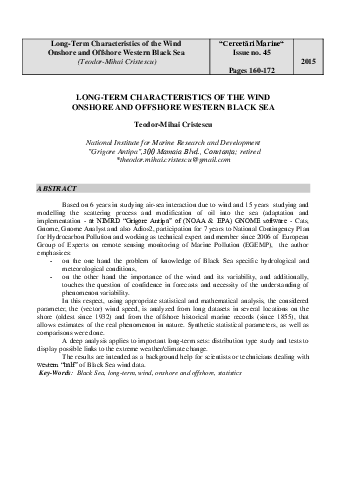Long-Term Characteristics of the Wind Onshore and Offshore Western Black Sea
DOI:
https://doi.org/10.55268/CM.2015.45.160Keywords:
Black Sea, long-term, wind, onshore and offshore, statisticsAbstract
Based on 6 years in studying air-sea interaction due to wind and 15 years studying and modelling the scattering process and modification of oil into the sea (adaptation and implementation - at NIMRD “Grigore Antipa” of (NOAA & EPA) GNOME software - Cats, Gnome, Gnome Analyst and also Adios2, participation for 7 years to National Contingency Plan for Hydrocarbon Pollution and working as technical expert and member since 2006 of European Group of Experts on remote sensing monitoring of Marine Pollution (EGEMP), the author emphasizes: - on the one hand the problem of knowledge of Black Sea specific hydrological and meteorological conditions, - on the other hand the importance of the wind and its variability, and additionally, touches the question of confidence in forecasts and necessity of the understanding of phenomenon variability. In this respect, using appropriate statistical and mathematical analysis, the considered parameter, the (vector) wind speed, is analyzed from long datasets in several locations on the shore (oldest since 1932) and from the offshore historical marine records (since 1855), that allows estimates of the real phenomenon in nature. Synthetic statistical parameters, as well as comparisons were done. A deep analysis applies to important long-term sets: distribution type study and tests to display possible links to the extreme weather/climate change. The results are intended as a background help for scientists or technicians dealing with western “half” of Black Sea wind data.
Downloads
Published
How to Cite
Issue
Section
License
This is an open access journal, which means that all content is freely available without charge to the user or his/her institution. Users are allowed to read, download, copy, distribute, print, search, or link to the full texts of the articles, or use them for any other lawful purpose, without asking prior permission from the publisher or the author. This is in accordance with the BOAI definition of open access.





